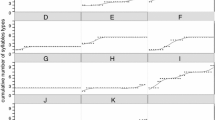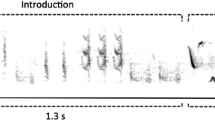Abstract
Fighting and flirting are the main evolutionary forces behind the development of bird song and both contribute to different song characteristics. By comparison of vocalisations throughout bird taxa, we can help to reconstruct the evolutionary history of the song. In this study, we provide the first detailed analysis of song structure and song type variability in the Black-headed Bunting (Emberiza melanocephala). We quantify the fine structural characteristics of the song and describe the song and syllable repertoire size. Further, we describe intraindividual song variability over time and interindividual song variability over space, and we explore whether this species uses syntactic rules to create songs. Our analyses reveal that the Black-headed Bunting has a short yet rather complex song and that the syllable pool is extensive. Its song is constructed of three parts that differ in both complexity and rhythm, suggesting the use of syntactic rules in constructing a song. The male song is typically built of 9–13 syllables, with 7–12 that are non-repetitive. Each male sings only one stereotyped song, which remains identical throughout the male’s lifespan, providing evidence for age-limited song learning. Songs are individually distinct, suggesting the importance of song in individual recognition of males. Two spatial levels of song variation in the Black-headed Bunting are shown. On a microgeographical level, relatively small song neighbourhoods are formed with a handful of birds singing the same song type. On a macrogeographical level, dialects can be distinguished by the end part of a song. The most striking feature of the male Black-headed Bunting song is the immense variability of song types. Typically, only a small number of males shared the same song type, and males with unique song types occurred frequently as well. The high song complexity and single-song repertoire found in the Black-headed Bunting could reflect a high level of polygyny and a low level of parental care, therefore pointing to strong intersexual selection on the male song.
Zusammenfassung
Aufbau und Variabilität des Gesangs männlicher Kappenammern (Emberiza melanocephala) Kämpfen und Flirten sind zwei wichtige Funktionen des Vogelgesangs und damit auch treibende Kräfte der Evolution, die zur Ausprägung von Vogelgesängen beitragen, dabei aber unterschiedliche strukturelle Merkmale fördern. Um die Evolution von Vogelgesängen zu rekonstruieren, ist unter anderem der Vergleich von Gesängen verschiedener Vogelarten eine wertvolle Methode. In dieser Studie präsentieren wir dazu die erste detaillierte quantitative Analyse und Beschreibung von Struktur und Variabilität des Gesangs männlicher Kappenammer (Emberiza melanocephala). Neben Gesangsaufbau, der Ausprägung von Gesangstypen und der Silbenrepertoiregröße werden intra- und interindividuelle Gesangsunterschiede sowie mögliche zugrundeliegende syntaktische Regeln untersucht. Unsere Analysen zeigen, dass männliche Kappenammern kurze aber komplexe Gesänge produzieren, die sie aus einem umfangreichen Silbenpool schöpfen. Der typische Gesang von Kappenammermännchen besteht aus drei Teilen, die sich in Komplexität und Rhythmus unterscheiden, was auf die Verwendung syntaktischer Regeln beim Gesangsaufbau hindeutet. Eine Gesangstrophe besteht typischerweise aus 9-13 Silben wovon 7-12 nicht wiederholt werden. Jedes Männchen produziert nur einen Strophentyp der über die gesamte Lebensdauer unverändert vorgetragen wird. Die Gesänge unterscheiden sich aber zwischen Männchen und dürften der individuellen Erkennung dienen. Bezüglich geografischer Unterschiede im Gesang zeigen sich gleiche oder ähnlichen Gesangstypen zwischen Nachbarn. Großräumig können Dialekte differenziert werden die sich durch den Endteil einer Strophe unterscheiden. Typisch für den Gesang männlicher Kappenammern ist eine Vielfalt an Strophentypen, wobei meist nur wenige Männchen denselben Strophentyp teilen, viele Männchen aber einzigartige Strophen produzieren. Die Tatsache, dass jedes Männchen nur einen Strophentyp produziert, die einzelnen Strophen aber relativ komplex sind, deuten auf eine hohe Neigung zu Polygynie und eine geringe Bereitschaft der Männchen, sich an der Brutfürsorge zu beteiligen hin. Intersexuelle Selektion dürfte also für den Gesang männlicher Kappenammern von großer Bedeutung sein.






Similar content being viewed by others
References
Andersson MB (1994) Sexual selection. Princeton University Press, Princeton
Baker MC, Boylan JT (1995) A catalog of song syllables of Indigo and Lazuli buntings. Condor 97:1028–1040. https://doi.org/10.2307/1369541
Baptista LF, Morton ML (1982) Song dialects and mate selection in montane white-crowned sparrows. Auk 99:537–547
Beecher MD (2008) Function and mechanisms of song learning in song sparrows. In: Brockmann HJ, Snowdon C, Roper T, Naguib M, Wynne-Edwards K, Barnard C, Mitani J (eds) Advances in the study of behavior, vol 38. Academic Press, pp 167–225
Beecher M, Brenowitz E (2005) Functional aspects of song learning in songbirds. Trends Ecol Evol 20:143–149. https://doi.org/10.1016/j.tree.2005.01.004
Beecher MD, Campbell SE, Nordby JC (2000) Territory tenure in song sparrows is related to song sharing with neighbours, but not to repertoire size. Anim Behav 59:29–37. https://doi.org/10.1006/anbe.1999.1304
Boardman TJ (1987) Microgeographic song variation in the Nuttall’s white-crowned sparrow. Condor 89:261–275
Brenowitz EA, Beecher MD (2005) Song learning in birds: diversity and plasticity, opportunities and challenges. Trends Neurosci 28:127–132. https://doi.org/10.1016/j.tins.2005.01.004
Briskie JV (1999) Song variation and the structure of local song dialects in the polygynandrous Smith’s Longspur. Can J Zool 77:1587–1594
Burt JM, Bard SC, Campbell SE, Beecher MD (2002) Alternative forms of song matching in song sparrows. Anim Behav 63:1143–1151. https://doi.org/10.1006/anbe.2002.3011
Byers BE, Kroodsma DE (2009) Female mate choice and songbird song repertoires. Anim Behav 77:13–22. https://doi.org/10.1016/j.anbehav.2008.10.003
Caro SP, Sewall KB, Salvante KG, Sockman KW (2010) Female Lincoln’s sparrows modulate their behavior in response to variation in male song quality. Behav Ecol 21:562–569. https://doi.org/10.1093/beheco/arq022
Catchpole CK, Slater PJB (2008) Bird song: biological themes and variations. Cambridge University Press, Cambridge
Chao A, Chazdon RL, Colwell RK, Shen T-J (2004) A new statistical approach for assessing similarity of species composition with incidence and abundance data: a new statistical approach for assessing similarity. Ecol Lett 8:148–159. https://doi.org/10.1111/j.1461-0248.2004.00707.x
Collins S (2004) Vocal fighting and flirting: the functions of birdsong. In: Marler P, Slabbekoorn H (eds) Nature’s music: the science of birdsong. Academic, San Diego, pp 39–79
Colwell RK (2013) EstimateS: statistical estimation of species richness and shared species from samples. Version 9. User's Guide and application. http://purl.oclc.org/estimates. Accessed 25 Feb 2015
ESRI (2009) ArcGis Desktop. ESRI, Redlands
Ewin J (1976) Song of the Reed Bunting Emberiza schoeniclus. Ibis 118:468–469
Handley HG, Nelson DA (2005) Ecological and phylogenetic effects on song sharing in songbirds. Ethology 111:221–238. https://doi.org/10.1111/j.1439-0310.2004.01043.x
Hultsch H, Todt D (2004) Learning to sing. In: Marler P, Slabbekoorn H (eds) Nature’s music: the science of birdsong. Academic, San Diego, pp 80–107
Kipper S, Kiefer S (2010) Age-related changes in birds’ singing styles: on fresh tunes and fading voices? In: Mitani J, Brockmann HJ, Roper T, Naguib M, Wynne-Edwards K (eds) Advances in the study of behavior, vol 41. Academic Press, pp 77–118
Kramer HG, Lemon RE, Morris MJ (1985) Song switching and agonistic stimulation in the song sparrow (Melospiza melodia): five tests. Anim Behav 33:135–149. https://doi.org/10.1016/S0003-3472(85)80127-5
Kreutzer ML (1990) Bird phonology and species recognition: minimal song units are cues inducing strong reactions in male cirl bunting (Emberiza cirlus). Ethol Ecol Evol 2:243–252. https://doi.org/10.1080/08927014.1990.9525409
Kroodsma D (2004) The diversity and plasticity of birdsong. In: Marler P, Slabbekoorn H (eds) Nature’s music. Academic, San Diego, pp 108–131
Leftwich C, Ritchison G (2000) Singing behavior of male Henslow’s Sparrows (Ammodramus henslowii). Bird Behav 18:1–7
Liu W-C, Kroodsma DE (1999) Song development by chipping sparrows and field sparrows. Anim Behav 57:1275–1286. https://doi.org/10.1006/anbe.1999.1081
Lohr B, Ashby S, Wakamiya SM (2013) The function of song types and song components in Grasshopper Sparrows (Ammodramus savannarum). Behaviour. https://doi.org/10.1163/1568539X-00003094
Marler P (1977) The structure of animal communication sounds. Recognition of complex acoustic signals: report of the Dahlem Workshop on recognition of complex acoustic signals. Abakon, Berlin, pp 17–35
Marler P, Slabbekoorn H (eds) (2004) Nature’s music: the science of birdsong. Academic, San Diego
Martens J, Kessler P (2000) Territorial song and song neighbourhoods in the Scarlet Rosefinch Carpodacus erythrinus. J Avian Biol 31:399–411. https://doi.org/10.1034/j.1600-048X.2000.310316.x
McGregor PK (1980) Song dialects in the Corn bunting (Emberiza calandra). Z Tierpsychol 54:285–297. https://doi.org/10.1111/j.1439-0310.1980.tb01246.x
Nelson DA, Poesel A (2009) Does learning produce song conformity or novelty in white-crowned sparrows, Zonotrichia leucophrys? Anim Behav 78:433–440. https://doi.org/10.1016/j.anbehav.2009.04.028
Nelson DA, Hallberg KI, Soha JA (2004) Cultural evolution of Puget Sound white-crowned sparrow song dialects. Ethology 110:879–908
Nordby JC, Campbell SE, Beecher MD (2002) Adult song sparrows do not alter their song repertoires. Ethology 108:39–50
O’Loghlen AL, Rothstein SI (2002) Ecological effects on song learning: delayed development is widespread in wild populations of brown-headed cowbirds. Anim Behav 63:475–486. https://doi.org/10.1006/anbe.2001.1951
O’Loghlen AL, Rothstein SI (2012) Delayed vocal ontogeny in songbirds: a laboratory study validates a model for delayed development derived from field studies. J Ethol 30:369–378. https://doi.org/10.1007/s10164-012-0334-0
Osiejuk TS (2011) The song of the Cinnamon-breasted Bunting, Emberiza tahapisi, in the Bamenda Highlands (NW Cameroon). J Ornithol 152:651–659. https://doi.org/10.1007/s10336-010-0626-5
Päckert M, Martens J, Kosuch J et al (2003) Phylogenetic signal in the song of crests and kinglets (Aves: regulus). Evolution 57:616–629
Payne RB, Payne LL (1997) Field observations, experimental design, and the time and place of learning bird songs. In: Snowdon CT, Hausberger M (eds) Social influences on vocal development. Cambridge University Press, Cambridge, pp 57–84
Peshek KR, Blumstein DT (2011) Can rarefaction be used to estimate song repertoire size in birds? Curr Zool 57:300–306
Petrusková T, Diblíková L, Pipek P et al (2015) A review of the distribution of Yellowhammer (Emberiza citrinella) dialects in Europe reveals the lack of a clear macrogeographic pattern. J Ornithol 156:263–273. https://doi.org/10.1007/s10336-014-1102-4
Pipek P, Petrusková T, Petrusek A et al (2017) Dialects of an invasive songbird are preserved in its invaded but not native source range. Ecography. https://doi.org/10.1111/ecog.02779
Read AF, Weary DM (1992) The evolution of bird song: comparative analyses. Philos Trans R Soc Lond B Biol Sci 338:165–187. https://doi.org/10.1098/rstb.1992.0137
Rising JD, Bonan A (2016) Buntings and new world sparrows (Emberizidae). In: del Hoyo J, Elliott A, Sargatal J et al (eds) Handbook of the birds of the world alive. Lynx, Barcelona
Rosenberg MS, Anderson CD (2011) PASSaGE: pattern analysis, spatial statistics and geographic exegesis. Version 2. Methods Ecol Evol 2:229–232. https://doi.org/10.1111/j.2041-210X.2010.00081.x
Searcy WA, Yasukawa K (1990) Use of the song repertoire in intersexual and intrasexual contexts by male red-winged blackbirds. Behav Ecol Sociobiol 27:123–128
Slater PJB (2003) Fifty years of bird song research: a case study in animal behaviour. Anim Behav 65:633–639
Soma M, Garamszegi LZ (2011) Rethinking birdsong evolution: meta-analysis of the relationship between song complexity and reproductive success. Behav Ecol 22:363–371. https://doi.org/10.1093/beheco/arq219
Specht R (2014) Avisoft-SASLab Pro. Avisoft Bioacoustics, Glienicke/Nordbahn
StatSoft (2007) STATISTICA (data analysis software system). StatSoft
Stoddard PK, Beecher MD, Willis MS (1988) Response of territorial male song sparrows to song types and variations. Behav Ecol Sociobiol 22:125–130. https://doi.org/10.1007/BF00303547
Tietze DT, Martens J, Sun Y-H, Päckert M (2008) Evolutionary history of treecreeper vocalisations (Aves: Certhia). Org Divers Evol 8:305–324. https://doi.org/10.1016/j.ode.2008.05.001
Tietze DT, Wassmann C, Martens J (2012) Territorial song does not isolate Yellowhammers (Emberiza citrinella) from Pine Buntings (E. leucocephalos). Vertebr Zool 62:113–122
Wonke G, Wallschläger D (2008) Song dialects in the yellowhammer Emberiza citrinella: bioacoustic variation between and within dialects. J Ornithol 150:117–126. https://doi.org/10.1007/s10336-008-0326-6
Acknowledgements
We thank Marko Barišić for making most of the audio recordings, villagers from Dazlina for allowing us to study birds on their land and for making our stay there a very pleasant experience, and especially Zdravko and Anka Muić, who generously welcomed us into their home. The study was partly funded by the Environmental Protection and Energy Efficiency Fund. We are grateful to anonymous reviewers and editors for providing helpful comments that improved the manuscript.
Author information
Authors and Affiliations
Corresponding author
Ethics declarations
Ethics approval
All applicable international, national, and/or institutional guidelines for the care and use of animals were followed. Bird capture and ringing were performed under a ringing licence (Institute of Ornithology, Croatian Academy of Sciences and Arts) and special authorisation for protected species from the Ministry of Environment and Energy (issued for each year of the study).
Additional information
Communicated by S. Kipper.
Appendix
Appendix
Acoustic material can be found at https://dx.doi.org/10.7479/yzvx-yn19.
Rights and permissions
About this article
Cite this article
Barišić, S., Ćiković, D., Tutiš, V. et al. Song structure and variability in the Black-headed Bunting (Emberiza melanocephala). J Ornithol 159, 389–400 (2018). https://doi.org/10.1007/s10336-017-1519-7
Received:
Revised:
Accepted:
Published:
Issue Date:
DOI: https://doi.org/10.1007/s10336-017-1519-7




